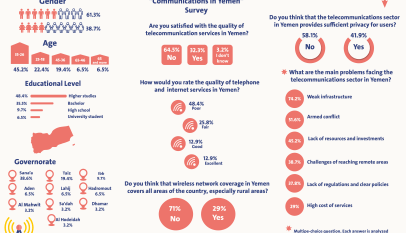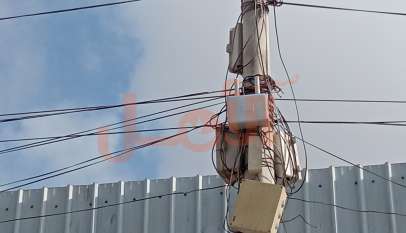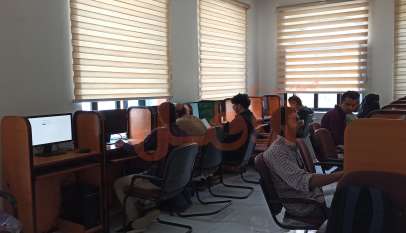The Telecommunications Sector in Yemen: Structural Challenges and an Uncertain Future
Eng. Muhammad Ahmad Ba-Yazid
General Manager of the Engineering Department in Hadhramaut Governorate
Fiber Optic Project Engineer FTTx
(Consultant for several telecommunications companies in Yemen)

When conflict erupts in a region, the world becomes filled with tension, leading to significant changes in economic sectors such as production and exports, vital sectors like oil and telecommunications, and a decline in investment in directly affected sectors. The conflict in Yemen has claimed the lives of thousands and forced millions to flee. Alongside the horrific armed conflict, another type of conflict has emerged, playing out in the telecommunications sector.
The telecommunications and information technology sector in Yemen is a fundamental component of the national infrastructure, representing the second most important source of income for the country after the oil sector. It also contributes to providing some significant direct and indirect employment opportunities through its links to other sectors of the national economy.
In September 2014, the armed conflict began in Yemen, which completely impacted the telecommunications sector. The local internet service provider, Yemen Net, was controlled by the parties to the conflict to manage content and local websites, as well as the domain name (.ye), which Yemeni websites could use instead of the (.com) domain.
According to a report issued by the Ministry of Communications and Information Technology in Sana’a, the total cost of damages and material losses incurred by the telecommunications and postal sector during the conflict in Yemen, up to March 2020, amounted to more than 4 billion dollars. This included the destruction of infrastructure, facilities, towers, stations, and exchanges; import bans; the detention of communication stations, equipment, and telecommunications and messaging equipment; and the ban on the use of the country’s-owned submarine cables, which have not yet entered service for political reasons. On the other hand, some sources estimated in March 2019 that about 200 out of 850 stations belonging to Yemen Mobile had partially or completely stopped operating due to the conflict.
The 2020 Yemen Needs Assessment, Phase III, conducted by the World Bank, found that 25% of Yemen’s telecommunications infrastructure has been partially damaged or destroyed since the conflict began. This estimate is likely an underestimate, as some towers and sites are not visible via satellite imagery. For example, the level of damage in Taiz Governorate was higher than what was assessed using satellite data. The most affected governorates are Sa’ada and Hodeidah, where 75% of infrastructure has been destroyed. Telecommunications companies are working to repair and rebuild damaged towers and networks whenever possible to ensure service continuity.
Telecommunications companies in Yemen have incurred significant financial losses due to frequent power outages and fuel shortages, which are needed to operate generators for key centers. Recently, the southern governorates have experienced natural disasters and cyclones that have caused damage to telecommunications companies, destroying and disrupting telecommunications towers and networks in those areas. This has resulted in a decline in coverage of approximately 40% due to a large number of stations going out of service, affecting telecommunications and internet services in many areas, such as Mahra, Hadhramaut, and Shabwa governorates.
In 2020, between January and March, Yemen and some Arab countries, such as Saudi Arabia, Oman, Kuwait, and others, experienced an outage of the “Falcon” submarine cable owned by Global Cloud Xchange, which runs near the Suez Canal. According to the company that owns the cable, the outage was caused by a large ship’s anchor cutting the cable completely. As Yemen relies primarily on this route to provide internet service to subscribers, this outage caused more than 80% of international internet service capacity to go out of service. This disruption lasted for over a month, causing complete paralysis of commercial transactions, domestic and international money transfers, vital businesses, and official functions throughout Yemen.
Other affected countries were not significantly impacted because they have other diverse landing points for a range of parallel and backup submarine cables. Yemen, however, has three submarine cable routes and landing points: the AAE1 submarine cable, in which the country invested $40 million, with a landing station in Aden; the SMW5 submarine cable, in which the country invested $29 million, with a landing point in Hodeidah; and the Aden-Djibouti submarine cable, with a landing point in Aden. These are the other country-owned alternatives that would have covered the deficit in capacity caused by the outage of the “Falcon” cable at that time. Due to the political conflict, all submarine routes were shut down except for the “Falcon” cable route and, more recently, the Aden-Djibouti route owned by the Yemeni government’s Aden Net company in the southern regions. Political circumstances and conflicts have led to the telecommunications sector losing opportunities to develop and update its technologies, exchange information, and adopt modern technologies to keep pace with the rapid development in the world.
In 2015, before the conflict, several licenses for companies operating in the sector were nearing expiration. However, the only company that was granted a license to provide 3G internet service was Yemen Mobile, which is owned by the country. The other mobile phone operating companies only received licenses to provide 2G or 2.5G services, which only offer limited internet connectivity.
Therefore, the process of renegotiating licenses for companies would have made it possible to offer next-generation mobile internet services. These restrictions that prevent companies from developing their technologies and services lead to indirect losses for companies, the telecommunications sector, and consumers alike. Meanwhile, the second source of indirect losses was the fragile, complex, and high-risk investment environment, which discouraged investors in the telecommunications sector from entering the Yemeni market, despite the large market size and the existence of many services that are not offered by the current companies operating in this sector.
The ongoing conflict has deepened the institutional divide in various economic and vital sectors, including the telecommunications sector. The Yemeni government has opened a new gateway to provide internet service (Aden Net) as a government provider of internet service with 4G technology.
Challenges Presented
Over the past five years, the world has witnessed tremendous technological and informational development in the field of communications. This sector has become closely linked to the knowledge economy, and economic and social development, and has been a catalyst for growth and development in all countries of the world. In contrast, in Yemen, the ongoing conflict has led to the deterioration of many sectors, most notably the telecommunications and information technology sectors. Its performance has not met the needs of subscribers for many reasons, including lack of coverage and interruption, especially in rural areas, city centers, and densely populated outskirts, difficulty in obtaining the service, as well as the very slow internet speed when used to obtain information.
The conflict has caused many problems for telecommunications companies, including frequent power outages, which have led to the complete shutdown of towers and exchanges in some areas. Companies have resorted to using generators, which has increased the cost of service due to the cost of fuel for the generators, which has become unavailable or very expensive.
As Yemen is experiencing a state of conflict and political divisions, there are challenges facing the telecommunications sector, the most prominent of which are:
Administrative Challenges
Damage to infrastructure: The ongoing conflict in Yemen has caused significant damage to the telecommunications infrastructure, including towers, fiber optic cables, and wireless links between towers (microwave stations), leading to disruptions in telecommunications services and reduced coverage in many areas.
Lack of investment in telecommunications: The Yemeni telecommunications market has seen almost no investment in the sector in recent years, limiting the expansion of networks and services. This has led to reduced coverage and limited access to telecommunications and internet services in some areas and their complete absence in some areas and villages.
Regulatory challenges and legal frameworks: The regulations and organizational structures for the telecommunications sector in Yemen have not changed since 1996, leading to poor service, limited revenue, and a failure to keep pace with rapid developments in the field of telecommunications and information technology.
Institutional division and politicization of the telecommunications sector: The conflict in Yemen has complicated developments in all areas, including telecommunications. It has resulted in conflicting policies that have confused service providers, affected the quality of services provided to subscribers, and put companies in a bind between Sana’a and Aden. Telecommunications operators are required to pay fees, licenses, and taxes to both parties.
Service monopoly: Due to the lack of updates to telecommunications regulations and laws, the service has become monopolized by some government and private companies that have existed since before the conflict. For many reasons, these companies have not undergone new updates or kept pace with technological advancements in the world. Additionally, there is a lack of proper separation between political, regulatory, and operational roles within the sector, especially concerning the provision of Internet service. This is evident in the government’s introduction of a single internet service provider, which has created an absolute monopoly in the internet market and led to a decline in the level of services provided and a significant increase in their prices, compared to other countries in the region and the world.
Technical challenges
Suspension of infrastructure repairs and updates: Since 2016, there have been no updates or repairs to telecommunications and internet services in Yemen. The telecommunications infrastructure has become fragile, leading to poor and weak service. Additionally, reliance on copper wires, which were created for telephone communications, instead of fiber optics, which are hundreds of times faster at transferring information, has further exacerbated the situation.
A complete ban on importing equipment and supplies necessary for the telecommunications sector: The import of all parts and technical equipment for repairing, developing, and upgrading stations, towers, exchanges, and cabins belonging to telecommunications companies has been banned. This has discouraged the process of modernization and the transition from third-generation technologies to fourth- and fifth-generation technologies and ultra-high-speed internet services such as FTTH technology for these companies.
The difficulty of updates and technical repairs: Due to the topography of Yemen and the areas of contact points and clashes witnessed in some areas, it has become difficult for equipment and technical crews to reach all governorates, cities, and villages for technical repairs, such as repairing interruptions in the main fiber optic cable paths, telecommunications towers, and networks.
Partial or complete outage of stations: The frequent power outages and fuel crises have led to a decrease in the number of telecommunications stations, with some going out of service. This has weakened coverage in some areas and completely stopped it in others.
Security concerns: The ongoing conflict in Yemen has also raised security concerns for many telecommunications companies, which have been forced to discourage development, modernization, and technical repairs in some contact areas. Technical crews have been delayed in carrying out repairs due to the political and military divisions of the regions. Some companies have resorted to investing in additional security measures to protect their networks and infrastructure, which has increased the financial burden on the service.
Financial challenges
The reluctance of a large number of subscribers to use the service: The duration of the conflict has witnessed a significant decrease in the number of service users due to the outage of a number of coverage stations in areas that have witnessed armed conflict, military strikes, or natural disasters, or their stoppage due to fuel shortages. This has forced subscribers to abandon the chips and landlines that were in everyone’s possession and to switch from one operator to another to obtain better coverage in different areas. As a result, the revenues of telecommunications companies have decreased significantly.
Exorbitant increase in obtaining the service: The acquisition of telecommunications services has become expensive due to the burden of operating costs and the service provided as a result of the duplication of financial collection by the parties to the conflict, such as license renewal fees, taxes, zakat, and others. This has forced telecommunications companies to add all the burdens to the price of the service and raise the tax rate on subscribers.
In general, these challenges have directly or indirectly limited the growth and development of the telecommunications sector in Yemen. Addressing them will be of paramount importance to improve access to telecommunications services and boost economic growth in the country.
Despite the significant deterioration in the infrastructure of the telecommunications and information technology sector in Yemen, and at a time when the world is witnessing rapid technological development in the field of the Internet and communications, the sector is seeking to update the infrastructure and provide fourth-generation services, fiber, and ultra-high-speed internet, but it faces difficulties in improving the quality of services due to the current political situation and the deterioration of the infrastructure, although Yemen was one of the leading countries in entering the era of communications and the Internet.
Recommendations and Treatments
There are many important recommendations to improve the performance of the telecommunications sector in Yemen and develop it within modern standards, which are divided into two parts:
• Part One
Urgent Recommendations
- Work on neutralizing the telecommunications and information technology sector, not involving it in political aspects, and not politicizing it to a specific party to the conflict in Yemen, to provide services efficiently and effectively throughout Yemen, and to stop targeting the infrastructure of the Internet and wired and wireless communications.
- Resolve and stop double taxation, and work on a specific mechanism to collect financial dues, taxes, and fees imposed on companies operating in the field of communications in Yemen.
- Change, update, and develop networks, and impose this on all service providers to reach modern technologies; such as the fourth and fifth generation and fiber optic technologies FTTH; to improve the ability of companies to diversify their offerings, and ensure the provision of services with better quality and acceptable prices for users.
- The government should ensure equal opportunities for all investors in the telecommunications and information technology sector, and make way for companies that can build telecommunications companies in the financial and technical fields; so that service prices remain at fair levels, and compete in providing the service that benefits subscribers and the economy of the state.
• Part Two
Non-Urgent Recommendations
These recommendations will not be initiated until a peace agreement is reached and the conflict ends. They include:
- Start developing serious plans to repair and operate the damaged submarine cables, such as the Aden-Djibouti cable, the SMW5 cable, and the AAE1 cable that extends from Southeast Asia to Europe, with a length of 25,000 kilometers, and provides a transmission capacity of up to 40 terabits per second, which is several times the capacity of the old submarine cable (Falcon). The country owns a share of the AAE1 cable estimated at approximately 1.8 terabits per second, out of the total cable capacity, and the country has contributed to its construction with about $40 million. It is one of the latest submarine cables for data transmission in the world.
- Open the field of investment in the telecommunications sector, specifically the Internet service provider. This field has become the monopoly of the government only, whether through the company (Telemen), (Yemen Net) or (Aden Net).
- Work on enacting laws for the new telecommunications sector in a manner that meets the needs of the market and enhances the role of the private sector and its partnership.
- Establish and develop a strong infrastructure, in line with the latest developments in telecommunications technology.
- Encourage competition in the local market by restructuring the relevant institutions to separate regulatory and operational roles. We are witnessing the breaking of the monopoly and allowing competing companies to enter the market to provide telecommunications and internet services.
- Work on establishing a comprehensive and comprehensive national digital strategy that contributes to comprehensive economic growth, in coordination with the private sector and civil society.
- Work on updating the curricula of university education and institutes of communication and information technology to keep pace with the rapid development in this field, and provide practical materials and specialized laboratories in the field of communication, in a way that meets the needs of the labor market for specialized workers.
- Strengthen the role of the telecommunications and information technology sector in public life; such as reducing the risks of natural disasters through available modern technologies, using them to survey affected areas, collect data about them, and assist in search and rescue operations.
- Benefit from the telecommunications and information technology sector in developing distance education, financial technology, social cash transfers, and remote work.
74.2% of Respondents in the Survey See the Lack of Infrastructure as One of the Most Prominent Problems Facing the Telecommunications Sector in Yemen
Sawt Al-Amal (Voice of Hope) – Yomna Ahmed The telecommunications sector is one of the mo…












